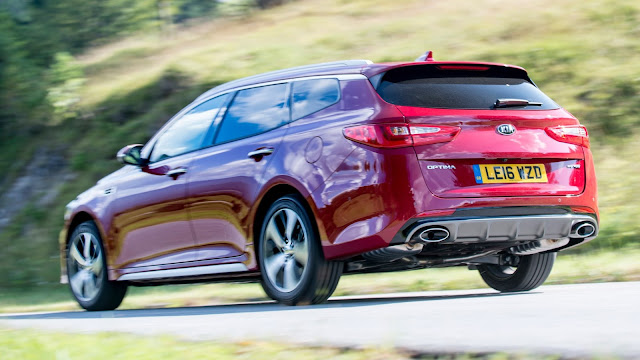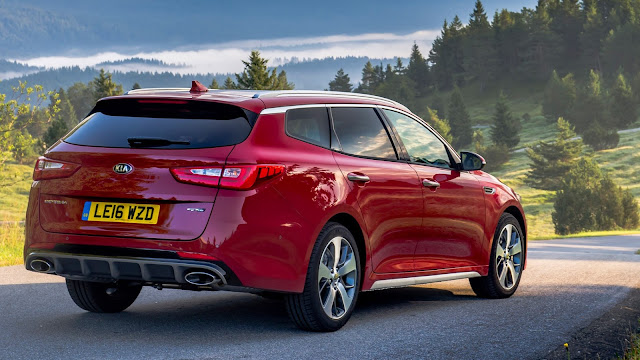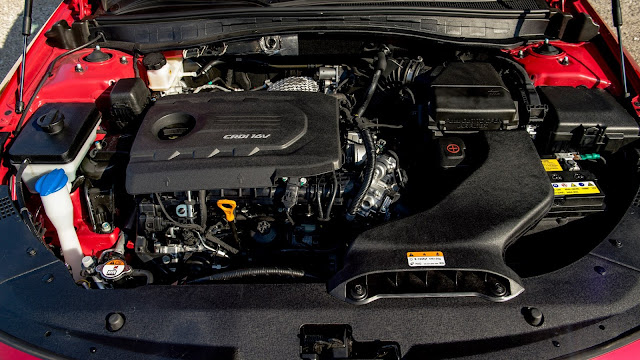Remember the Kia Sportspace? That fabulous-looking shooting brake with an Alfa Romeo Brera-like rear end and individual carbon buckets inside? Well Kia’s only gone and made it. Sort of.
It’s called the Optima Sportswagon now, but in the transition from concept to production a few appealing elements have changed. For example, the honeycomb rear diffuser and smart-looking wheels.
Positives include a 552-litre boot and newly tuned suspension said to represent the sportier, more engaging direction Kia is heading – under the charge of its new M Division-sourced head of performance.
Without a doubt, this is a very important car for Kia. It’s the company’s first estate in this segment, and is expected to form the majority of Optima sales in Europe when it lands in September.
Why hasn’t Kia made a large estate before?
Simply put, Europe is Kia’s only market for such a car – and the Korean manufacturer didn’t previously have the capacity to produce vehicles for a single region.
However, the opening of a new plant in Mexico has freed up factory time back home in Hwasung, enabling all sorts of Euro-spec models – like this new Optima Sportswagon and the hybrid-powered Niro.
It’s expected to be big business over here, making up 66% of European Optima registrations, with fleet sales making up three in every four UK cars.
Tell me more about this new chassis set-up...
In case you missed the news, Kia’s all about the fun now. This new estate is one of the company’s first cars to be fettled by former M Division vice president Albert Biermann, and represents the pencil-sketch of the future line drawn between comfort and performance.
‘Our existing customers are used to a certain driving experience,’ Biermann said. ‘They are happy with the value for money and quality, and many don’t care about the driving experience.
‘We cannot make too radical changes; we carefully have to add this driving enjoyment, because we want customers in our cars that are currently driving something else.’
Ramping up the excitement without alienating existing customers means while you get the same independent suspension set up as the saloon, the spring and damper rates have been tuned to help counteract the new weight distribution and higher sides, and the traction control software has been remapped to work with you, rather than against.
Sounds good, but does it work?
On Kia’s brand-new handling circuit in the its Namyang R&D centre, the wagon both surprised and delighted, tackling tight turns and fast chicanes with promising prowess. Grip levels are high and the steering system offers up satisfying weight and easily judged responses.
The biggest improvement comes from the stability control system that feeds in gently at the car’s limits, rather than chucking an anchor out of the back window at the first sniff of understeer, like Kias of old. We got quite used to seeing the familiar skidding-car light blinking in the dashboard as the Optima subtly reigned in our clog-footed inputs.
Biermann added: ‘Some of our cars had a rough intervention with no power – something we have improved. It is still safe and stable but it is much faster than before. In fact I can drive at the Nurburgring with the system fully on and not lose a second; we can make our cars faster with the system on than with it off.’
Good news for helmsmiths of a reasonably-priced-company-estate persuasion, but if mere mentions of ’ring prowess give you the first twinges of sciatica, fear not – we also drove on a mix of roads from the smooth tarmac of inner-city Seoul to the rippled and speed-bump-peppered rural thoroughfares, and found the ride to be as good as you would expect from a Kia.
Does it have an engine to match?
For the time being, no; you have to make do with the existing 1.7-litre diesel unit fitted to the saloon. It’s a fine all-rounder – not particularly exciting, but delivering adequate performance and worthy economy to impress your fleet manager with.
It churns out 139bhp and 251lbs ft, produces 120g/km of CO2 in an automatic like ours, and clocks a claimed fuel economy of 61.4mpg. Manual cars are a bit quicker from 0-60mph, taking 9.8 seconds to the seven-speed dual-clutch car’s 10.7.
Automatic versions are a bit less taxing to drive in traffic but the six-speed ’box carries only a small ease-of-use penalty, thanks to its slick throw and light clutch. The DCT feels calibrated for economy, quickly seeking out taller gears, so the manual’s the one to go for if you’re in a rush.
What’s it like inside?
Spacious and practical, and assembled and finished to a higher standard than you might expect. You won’t find much in the way of cheap plastic or rattling bits of trim, for example. Adding to its decent feel are touches like an intuitive media system that responds quickly.
You get stacks of kit for you money, too. The GT-Line S comes with an extensive equipment list that includes a wireless mobile phone charger, adaptive cruise control, a 360-degree camera, a harman/kardon sound system, sat-nav and dual-zone climate.
I want a really fast one though…
Our car in GT-Line S trim certainly looked the part, with 18-inch alloy wheels, a subtle body kit and dual chrome-tipped exhaust pipes poking out of a racy rear diffuser. The estate is identical to the saloon up to the B-pillar too so you get the same significantly better interior.
For style and substance though you’ll want the Kia Optima Sportswagon GT, which features a new four-pot 2.0-litre turbocharged engine that punches out 242bhp and 260lb ft.
Expect this newly found desire for driver enjoyment to be ramped up to previously unimaginable levels (for Kia), sitting somewhere below fairly warm estate derivatives from BMW and Mercedes-AMG.
Verdict
Do you like the saloon but want a bigger boot? Then crack on, as the Kia Optima Sportswagon will cost you barely £1000 more.
It might seem like we’ve come the long way around to a simple conclusion, but big estates can easily fall into the wobbly flat-pack misery-barge trap, and what Kia has produced here is the opposite – a wagon that carries no real penalty over the saloon other than a couple of grams of CO2 and slightly higher price. Impressive stuff.
Even so, more enthusiastic drivers looking for the next alternative to a Skoda Octavia vRS estate should wait for the faster GT version, though. This GT Line car looks the part but is more expense and slower than the manual-equipped lower grades.
(carmagazine.co.uk)













0 comments :
Post a Comment